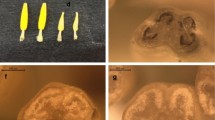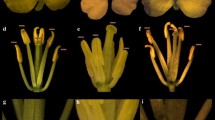Abstract
Cytoplasmic male sterility (CMS) has been used in the breeding of sugar beet for decades but is also more generally an important feature of the reproductive system in its wild relative, Beta vulgaris ssp. maritima. Among the several CMSs found in wild populations, the G CMS is a mitochondrial variant of the respiratory chain. The segregants derived from a cross between a restored plant and a female (male-sterile) plant on G cytoplasm exhibited three sexual phenotypic classes: female, hermaphrodite and intermediate. The pattern of segregation suggests a genetic inheritance with two loci in epistatic interaction. Nevertheless, it was possible to apply a bulk segregant analysis approach to search for AFLP and microsatellite markers linked to the restorer locus (RfG 1 ) which controls the capacity to produce pollen [female versus non female (i.e. intermediates and hermaphrodites)] in the segregating population. A linkage group was constructed with four AFLP markers and nine microsatellites, and a total size of 40 cM (Kosambi). The closest marker, a microsatellite, was totally linked to RfG1, which was also flanked by two AFLP markers delimiting a 5 cM window. This linkage group was identified as being chromosome VIII where neither of the restorer loci of the Owen CMS are located.


Similar content being viewed by others
References
Abad AR, Mehrtens BJ, Mackenzie SA (1995) Specific expression in reproductive tissues and fate of a mitochondrial sterility-associated protein in cytoplasmic male-sterile bean. Plant Cell 7:271–285
Alexander MP (1969) Differential staining of aborted and non-aborted pollen. Stain Technol 44:117–122
Bailey MF (2002) A cost of restoration of male fertility in a gynodioecious species, Lobelia syphilitica. Evolution 56:2178–2186
Bailey MF, Delph LF, Lively CM (2003) Modeling gynodioecy: novel scenarios for maintaining polymorphism. Am Nat 161:762–776
Bentolila S, Alfonso AA, Hanson MR (2002) A pentatricopeptide repeat-containing gene restores fertility to cytoplasmic male-sterile plants. Proc Natl Acad Sci USA 99:10887–10892
Boutin-Stadler V, Saumitou-Laprade P, Valero M, Jean R, Vernet P (1989) Spatio-temporal variation of male sterile frequencies in two natural populations of Beta maritima. Heredity 63:395–400
Brown GG, Formanova N, Jin H, Wargachuk R, Dendy C, Patil P, Laforest M, Zhang J, Cheung WY, Landry BS (2003) The radish Rfo restorer gene of Ogura cytoplasmic male sterility encodes a protein with multiple pentatricopeptide repeats. Plant J 35:262–272
Budar F, Touzet P, De Paepe R (2003) The nucleo-mitochondrial conflict in cytoplasmic male sterilities revisited. Genetica 117:3–16
Butterfass (1964) Die Chloroplastenzahlen in verschiedenartigen Zellen trisomer Zuckerrüben (Beta vulgaris L.). Z Bot 52:46–77
Charlesworth D (1981) A further study of the problem of the maintenance of females in gynodioecious species. Heredity 46:27–39
Charlesworth D, Laporte V (1998) The male sterility polymorphism of Silene vulgaris: Analysis of genetic data from two populations, and comparison with Thymus vulgaris. Genetics 150:1267–1282
Collin CL, Shykoff JA (2003) Outcrossing rates in the gynomonoecious-gynodioecious species Dianthus sylvestris (Caryophyllaceae). Am J Bot 90:579–585
Cosmides LM, Tooby J (1981) Cytoplasmic inheritance and intragenomic conflict. J Theor Biol 89:83–129
Cuguen J, Wattier R, Saumitou-Laprade P, Forcioli D, Mörchen M, Van-Dijk H, Vernet P (1994) Gynodioecy and mitochondrial DNA polymorphism in natural populations of Beta vulgaris ssp. maritima. Genet Sel Evol 26:87–101
Cui X, Wise RP, Schnable PS (1996) The rf2 nuclear restorer gene of male-sterile T-cytoplasm maize. Science 272:1334–1336
De Haan AA, Koelewijn HP, Hundscheid MPJ, Van Damme JMM (1997a) Dynamics of gynodioecy in Plantago lanceolata L. II. Mode of action and frequencies of restorer alleles. Genetics 147:1317–1328
De Haan AA, Hundscheid MPJ, van Hinsberg A (1997b) Effects of CMS types and restorer alleles on plant performance on Plantago lanceola L.:an indication for cost of restoration. J Evol Biol 10:803–820
Delourme R, Bouchereau A, Hubert N, Renard M, Landry BS (1994) Identification of RAPD markers linked to a fertility restorer gene for the Ogura radish cytoplasmic male sterility of rapeseed (Brassica napus L.). Theor Appl Genet 88:741–748
Desloire S, Gherbi H, Laloui W, Marhadour S, Clouet V, Cattolico L, Falentin C, Giancola S, Renard M, Budar F, Small I, Caboche M, Delourme R, Bendahmane A (2003) Identification of the fertility restoration locus, Rfo, in radish, as a member of the pentatricopeptide-repeat protein family. EMBO Rep 4:588–594
Dill CL, Wise RP, Schnable PS (1997) Rf8 and Rf* mediate unique T-urf13-transcript accumulation, revealing a conserved motif associated with RNA processing and restoration of pollen fertility in T-cytoplasm maize. Genetics 147:1367–1379
Ducos E, Touzet P, Boutry M (2001) The male sterile G cytoplasm of wild beet displays modified mitochondrial respiratory complexes. Plant J 26:171–180
Frank SA (1989) The evolutionary dynamics of cytoplasmic male sterility. Am Nat 133:345–376
Gigord L, Lavigne C, Shykoff J, Atlan A (1999) Evidence for effects of restorer genes on male and female reproductive functions of hemaphrodites in the gynodioecious species Thymus vulgaris L. J Evol Biol 12:596–604
Gouyon PH, Vichot F, Van Damme JMM (1991) Nuclear-cytoplasmic male sterility: single point equilibria versus limit cycles. Am Nat 137:498–514
Halldén C, Bryngelsson T, Bosemark NO (1988) Two new types of cytoplasmic male sterility found in wild Beta beets. Theor Appl Genet 75:561–568
Hansen M, Kraft T, Christiansson M, Nilsson N-O (1999) Evaluation of AFLP in Beta. Theor Appl Genet 98:845–852
He SC, Lyznik A, Mackenzie S (1995) Pollen fertility restoration by nuclear gene Fr in cms bean—nuclear-directed alteration of a mitochondrial population. Genetics 139:955–962
Hjerdin-Panagopoulos A, Kraft T, Rading I, Tuvesson S, Nilsson N-O (2002) Three QTL regions for restoration of Owen CMS in sugar beet. Crop Sci 42:540–544
Iwabuchi M, Kyozuka J, Shimamoto K (1993) Processing followed by complete editing of an altered mitochondrial atp6 RNA restores fertility of cytoplasmic male sterile rice. EMBO J 12:1437–1446
Koelewijn HP (1996) Sexual differences in reproductive characters in gynodioecious Plantago coronopus. Oikos 75:443–452
Koelewijn HP, Van Damme JMM (1995) Genetics of male sterility in gynodioecious Plantago coronopus. II. Nuclear genetic variation. Genetics 139:1759–1775
Koizuka N, Imai R, Fujimoto H, Hayakawa T, Kimura Y, Kohno-Murase J, Sakai T, Kawasaki S, Imamura J (2003) Genetic characterization of a pentatricopeptide repeat protein gene, orf687, that restores fertility in the cytoplasmic male-sterile Kosena radish. Plant J 34:407–415
Lander E, Green P, Abrahamson J, Barlow A, Daly M, Lincoln S, Newburg L (1987) MAPMAKER: an interactive computer package for constructing primary genetic linkage maps of experimental and natural populations. Genomics 1:174–181
Laporte V, Merdinoglu D, Saumitou-Laprade P, Butterlin G, Vernet P, Cuguen J (1998) Identification and mapping of RAPD and RFLP markers linked to a fertility restorer gene for a new source of cytoplasmic male sterility in Beta vulgaris ssp. maritima. Theor Appl Genet 96:989–996
Laporte V, Viard F, Béna G, Valero M, Cuguen J (2001) The spatial structure of sexual and cytonuclear polymorphism in the gynodioecious Beta vulgaris ssp. maritima: I/ at a local scale. Genetics 157:1699–1710
Laughan JR, Gabay-Laughan S (1983) Cytoplasmic male sterility in maize. Annu Rev Genet 17:27–48
Leclercq P (1984) Identification de gènes de restauration de fertilité sur cytoplasmes stérilisants chez le tournesol. Agronomie 4:573–576
Li X-Q, Jean M, Landry BS, Brown GG (1998) Restorer genes for different forms of Brassica cytoplasmic male sterility map to a single nuclear locus that modifies transcripts of several mitochondrial genes. Proc Natl Acad Sci USA 95:10032–10037
Michelmore RW, Paran I, Kesseli RV (1991) Identification of markers linked to disease-resistance genes by bulked segregant analysis: A rapid method to detect markers in specific genomic regions by using segregating populations. Proc Natl Acad Sci USA 88:9828–9832
Mikami T, Kishima Y, Sugiura M, Kinoshita T (1985) Organelle genome diversity in sugar beet with normal and different sources of male sterile cytoplasms. Theor Appl Genet 71:166–171
Owen FV (1942) inheritance of cross- and self-sterility and self-fertility in Beta vulgaris. J Agric Res 64:679–698
Owen FV (1945) Cytoplasmically inherited male-sterility in sugar beet. J Agric Res 71:423–440
Pruitt KD, Hanson MR (1991) Transcription of the Petunia mitochondrial cms-associated Pcf locus in male sterile and fertility-restored lines. Mol Gen Genet 227:348–355
Rae SJ, Aldam C, Dominguez I, Hoebrechts M, Barnes SR, Edwards KJ (2000) Development and incorporation of microsatellite markers into the linkage map of sugar beet (Beta vulgaris ssp.). Theor Appl Genet 100:1240–1248
Saumitou-Laprade P, Cuguen J, Vernet P (1994) Cytoplasmic male sterility in plants: molecular evidence and the nucleocytoplasmic conflict. Trends Ecol Evol 9:431–435
Schnable PS, Wise RP (1998) The molecular basis of cytoplasmic male sterility and fertility restoration. Trends Plant Sci 3:175–180
Schondelmaier J, Jung C (1997) Chromosomal assignment of the nine linkage groups of sugar beet (Beta vulgaris L.) using primary trisomics. Theor Appl Genet 95:590–596
Shykoff J (1988) Maintenance of gynodioecy in Silene acaulis (Caryophyllaceae): stage-specific fecundity and viability selection. Am J Bot 75:844–850
Small ID, Peeters N (2000) The PPR motif—a TPR-related motif prevalent in plant organellar proteins. Trends Biochem Sci 25:46–47
Sokal RR, Rohlf FJ (1995) Biometry. Freeman, New York
Tang VH, Chang R, Pring DR (1998) Cosegregation of single genes associated with fertility restoration and transcript processing of sorghum mitochondrial orf107 and urf209. Genetics 150:383–391
Thompson JD, Tarayre M (2000) Exploring the genetic basis and proximate causes of female fertility advantage in gynodioecious Thymus vulgaris. Evolution 54:1510–1520
Touzet P (2002) Is rf2 a restorer gene of CMS-T in maize? Trends Plant Sci 7:434
Vos P, Hogers R, Bleeker M, Reijans M, Lee van de T, Hornes M, Frijters A, Pot J, Peleman J, Kuiper M, Zabeau M (1995) AFLP: a new technique for DNA fingerprinting. Nucleic Acids Res 23:4407–4414
Wise RP, Pring DR (2002) Nuclear-mediated mitochondrial gene regulation and male fertility in higher plants: Light at the end of the tunnel? Proc Natl Acad Sci USA 99:10240–10242
Yao F, Xu C, Yu S, Gao Y, Li X, Zhang Q (1997) Mapping and genetic analyses of two fertility restorer loci in the wild-abortive cytoplasmic male sterility system of rice (Oryza sativa L.). Euphytica 98:183–187
Yui R, Iketani S, Mikami T, Kubo T (2003) Antisense inhibition of mitochondrial pyruvate dehydrogenase E1a subunit in anther tapetum causes male sterility. Plant J 34:57–66
Acknowledgements
We thank Anne-Sophie Wepierre and Marianne De Paepe for preliminary flower phenotyping, Robert Dron for his technical expertise in plant care, Hans Koelewijn and Jean-François Arnaud for valuable comments on the manuscript. This work was supported by grants from the Région Nord-Pas de Calais and the European Community (European Regional Development Fund).
Author information
Authors and Affiliations
Corresponding author
Additional information
Communicated by H.C. Becker
Rights and permissions
About this article
Cite this article
Touzet, P., Hueber, N., Bürkholz, A. et al. Genetic analysis of male fertility restoration in wild cytoplasmic male sterility G of beet. Theor Appl Genet 109, 240–247 (2004). https://doi.org/10.1007/s00122-004-1627-7
Received:
Accepted:
Published:
Issue Date:
DOI: https://doi.org/10.1007/s00122-004-1627-7




